J. Cent. South Univ. Technol. (2011) 18: 2015-2020
DOI: 10.1007/s11771-011-0936-7
CFD analysis of sound pressure in tank gun muzzle silencer
Hafizur Rehman1, Hanshik Chung1, Taewhee Joung2, A. Suwono3, Hyomin Jeong1
1. Department of Mechanical and Precision Engineering, Gyeongsang National University,
The Institute of Marine Industry, 445 Inpyeong Dong, Tongyeong 650-160, Gyeongsang Nam do, South Korea;
2. Eco-Friendly Heat & Cold Energy Mechanical Research Team, Gyeongsang National University,
445 Inpyeong Dong, Tongyeong 650-160, Gyeongsang Nam do, South Korea;
3. Faculty of Mechanical and Aerospace Engineering, Bandung Institute of Technology, Indonesia
? Central South University Press and Springer-Verlag Berlin Heidelberg 2011
Abstract: The high pressure waves generated due to muzzle blast flow of tank gun during firing is a critical issue to examine. The impulsive noise from the gun has various negative effects such as damage of human bodies, damage of structures, creating an environmental, social problem and also military problems such as exposure of location of troops. This high pressure impulsive sound, generated during the blast flow, was studied and attenuated. An axisymmetric computational domain was constructed by employing Spalart Allmaras turbulence model. Approximately 90% of pressure and 20 dB of sound level are reduced due to the use of the three baffle silencer at the muzzle end of the gun barrel, in comparison with the tank gun without silencer. Also, the sound pressure level at different points in the ambient region shows the same attenuation in results. This study will be helpful to understand the blast wave characteristics and also to get a good idea to design silencer for large caliber weapon system.
Key words: baffle silencer; muzzle blast; impulsive noise; decibel; tank-gun
1 Introduction
Due to firing of tank guns, a high intensity sound pressure is created in form of muzzle blast wave. In fact, this muzzle blast is produced due to the explosion of the propellant inside the gun barrel. The deflagration of the propellant in the chamber produces an abrupt expansion of gases. This rapid increase in volume causes pressure waves which accelerate the projectile into flight from the muzzle end of the barrel and as result of this high intensity muzzle blast, impulsive sound is heard. Compared with other sound, the impulsive sound has several special features and different properties, such as low frequency, strong directivity and long range propagation [1-2]. That’s why it can easily reach surrounding areas and communities. The impulsive noise from the gun has various negative effects such as damage to human bodies, damage of structures, creating an environmental, social problem and also military problems such as exposure of location of troops.
The parameters which cause this high intensity noise are muzzle blast, sabot discard, projectile flight and explosion of the projectile at the target etc. There are two main sources of impulsive noise from the firing, i.e. gun blast noise and projectile bow shock noise [3]. The gun blast is highly directional, therefore sound effect at the locations directly in front of the gun is about 15 dB higher than that for equidistance locations directly to the rear of the gun. The projectile bow shock noise only occurs forward the gun, in a region determined by the supersonic velocity of the projectile. This noise is localized nearer to the gun if the slug is unstable in flight and thus decelerates quickly to subsonic speeds [3-4].
The noise from the tank guns and cannons is directed predominantly to the front and is attenuated much less over water than over vegetated land. According to some experimental investigation, the noise levels due to high pressure blast flow could be heard about 10 miles away from the firing point at a level of 90 dB [1, 3].
Thus, in the view of all above facts, the study of blast wave and impulsive sound attenuation is of great importance.
Silencers or mufflers are used to reduce this muzzle blast flow noise. Silencers have to be designed especially, so that they allow gun gases to expand into chamber volumes properly to get the maximum pressure reduction. The attenuation of silencer generally increases with its internal volume. Attenuation increases with the number of baffles but only up to a certain value and then decreases thereafter. The attenuation also depends on the length of the inlet chamber, the placement of the silencer, and the whole size of projectile. The suppression of the muzzle blast is important in both large caliber weapon system and small caliber weapon system designs. In case of large caliber weapon system, the design of silencer has relied heavily on experimental work and the development of empirical databases [1, 5].
The study on impulsive noise is divided into two categories: noise attenuation and blast wave analysis. In the present study, the impulsive sound attenuation, by using a three baffle silencer during high pressure blast flow, has been analyzed. For this study, large caliber 120 mm K1A1 tank gun has been selected especially.
For evaluation, the designing work, simulation and results, Gambit, CFD and Fluent software has been used. A three baffle silencer has been fitted at the muzzle end of the barrel. The simulated results of pressure and sound pressure level at different points inside the silencer and also at different points in the ambient region have been compiled and compared with the results at the same points without using silencer.
2 Governing equation
For a three-dimensional, turbulent, unsteady and compressible flow, the governing equation is expressed as
 (1)
(1)
where Q, E, F and G denote the dependent variables and flux vectors.
The Spalart Allmaras equation for aerodynamic flow is expressed as

 (2)
(2)
where
 (3)
(3)
 (4)
(4)
And  and
and 
The far field boundary condition is

And the turbulent eddy viscosity is computed from
 (5)
(5)
where

 (6)
(6)
Additional definitions are given by the following equations:

 (7)
(7)
Also, shear stress can be expressed by laminar viscous coefficient and eddy viscous coefficient as
 (8)
(8)
As per ideal gas equation, the pressure p is given by
 (9)
(9)
3 Numerical analysis and simulations
In order to do the simulation for this case by using appropriate numerical solver, a validation case study with sufficient quantitative and qualitative information about the very complex flow-field created by muzzle blast is necessary to properly validate the computational fluid dynamics (CFD) techniques. For this, a CFD analysis of 7.62 mm NATO rifle G3 with a DM-41 round was selected about the flow-field in the form of shadowgraph images and analysis. This problem was tested in Refs.[6-8].
Figure 1 shows the reference shadow graphs and the validated fluent shadow graphs. Also Fig.2 shows the pressure graph at initial condition of the reference for 7.62 mm NATO rifle G-3.
After getting validation of the above shadow graphs, computational fluid dynamics analysis has been applied to analyzing the supersonic blast flow and for design work Gambit software has been used. The basic domain has been made from the specifications and data of 120 mm caliber K1A1 tank gun barrel, as listed in Table 1. The designing work has been made by using Gambit and analyzed by using fluent.
A density based axisymmetric, unsteady state condition with ideal gas as fluid has been used. First order implicit scheme is used for time integration and also the Spalart-Allmaras S.A (1-eqn) turbulence model is used. Additionally, the multi-block grid technique has been applied to analyzing the complicated geometry of the gun muzzle.
3.1 CFD modeling and simulation for high pressure blast flow field without silencer
To investigate the high pressure supersonic blast flow field with a silencer, first the same case without installing silencer at the muzzle end of the gun is analyzed. After that, the achieved data are compared with the results achieved with silencer case.
Figures 3 (a) and (b) show the schematic diagram of the computational domain, initial condition, and boundary condition of 120 mm K1A1 gun without silencer respectively and Fig.4 shows the maximum pressure graph at inlet condition.

Fig.1 Reference shadow graphs (a) and fluent validated shadow graphs (b) at different time intervals: (a1) and (b1) texp≈3.5×10-3 ms; (a2) and (b2) texp≈3.7×10-3 ms

Fig.2 Reference pressure graph at initial condition for 7.62 mm NATO rifle G3
Table 1 Specifications of 120 mm K1A1 tank gun

In order to get the impulsive sound pressure level in the open field area, different points have been taken at a radial distance of R2 and R4 from the muzzle end. These points have been taken at an angle of 0°, 15°, 30°, 45°, 60° and 90°, as shown in Fig.3(a).
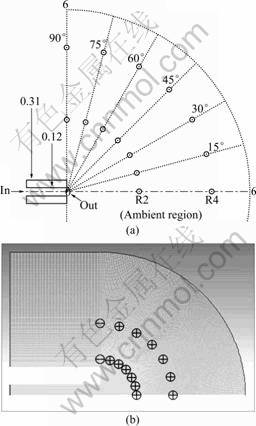
Fig.3 Schematic diagram (a) and boundary condition and mesh diagram (b) without silencer for 120 mm tank gun
3.2 CFD modeling and simulation for high pressure blast flow field with silencer
The schematic diagrams of computational domain, boundary condition, mesh and CFD diagram for the 120 mm K1A1 tank gun after installing three baffle silencer are shown in Figs.5(a), (b) and (c), respectively.
To get the comparison result of sound pressure level in the ambient region after installing these silencers, all the points have been taken at same distances and angles as above case. Detail is shown in Fig.5(a).

Fig.4 Pressure-time plot at inlet condition for 120 mm K1A1 tank gun
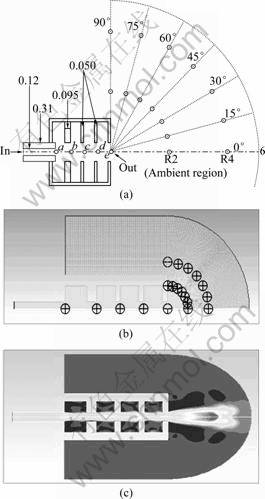
Fig.5 Schematic and CFD animation diagram (a), boundary condition and mesh diagram (b) and CFD diagram (c) with three baffle silencers for 120 mm tank gun
4 Results and discussion
The pressure graph at five different points inside the silencer is shown in Fig.6(a) and CFD diagram of blast wave formation inside the barrel at the acquisition points is shown in Fig.6(b). Furthermore, Table 2 describes the comparison results at these points.
From Fig.6(a) and Table 2, it is clear that due to influences of the propellant shock wave, pressure variation and sound pressure level at point a are recorded as 300 MPa and 263 dB, respectively. After first baffle at point b, the pressure gets to 200 MPa and the sound level is 260 dB. After second baffle at point c, the pressure gets to 170 MPa and the sound level is 258 dB. After third baffle at point d, the pressure gets to 105 MPa and the sound level is 254 dB. And at the exit point e of the silencer, the pressure and sound level are recorded as 50 MPa and 244 dB, respectively.

Fig.6 Pressure graph at five different points inside silencer (a) and blast wave formation diagram (b) inside gun barrel points
Table 2 Pressure and sound pressure level at five points inside silencer

In view of the above results, it is concluded that, approximately 90% of pressure and 20 dB of sound pressure level have been attenuated due to use of the three baffle silencers.
Figure 7 shows the pressure graphs at different points with and without silencer, which have taken at different angles at a radial distance of R2 in the ambient region. Table 3 illustrates the comparison results of pressure and sound level at these points. Detail of the points has been already shown in Fig.5(a).
Similarly, Table 4 gives the comparison result of pressure and sound pressure level at the different points with and without silencer, at same angles but at a radial distance of R4 in the ambient region.
From Table 3, it is clear that the reduction in pressure and sound level at R2 and angle 0° is 82% and 14 dB, whereas at 90° the reduction is 92% and 22 dB. Similarly, from Table 4, the reduction in pressure and sound level, recorded at point R4 and angle 0° is 85% and 16 dB, whereas at 90°, the reduction is 90% and 20 dB, respectively.

Fig.7 Pressures at different points taken at radial distance of R2 in ambient region: (a) 0°; (b) 15°; (c) 45°; (d) 60°; (e) 90°
Table 3 Pressure and sound pressure level at different points at R2 in ambient region
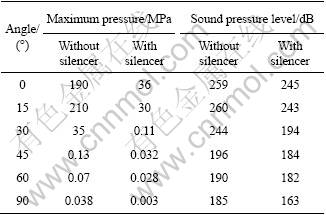
Table 4 Pressure and sound pressure level at different points at R4 in ambient region
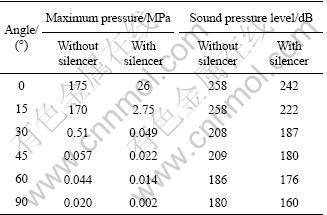
5 Conclusions
The CFD analysis of impulsive sound pressure and also attenuation of sound pressure, generated by large caliber gun during blast flow is conducted. Due to use of three baffle silencers at the muzzle end of gun barrel, a considerable amount of propellant energy has dissipated inside the chamber volume of the silencer and also the sound pressure level is diminished. Approximately 90% of pressure and 20 dB of sound level are reduced, in comparison with the gun without silencer. The results of this study will be helpful to understanding the blast wave characteristics as well as in design of silencers for large caliber weapon system.
Nomenclature
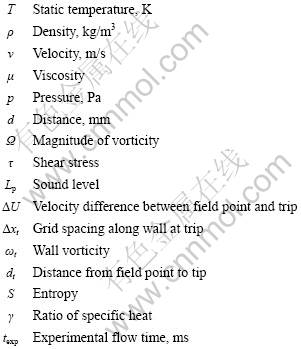
References
[1] KANG K J, KO S H, LEE D S. A study on impulsive sound attenuation for a high pressure blast flowfield [J]. Journal of Mechanical Science and Technology, 2007, 22(1): 190-200.
[2] COOKE C H, FANSLER K S. Numerical simulation and modeling of a muffler [R]. Memorandum Report BLR-MR-3735, 1989.
[3] FANSLER K S, von WAHLDE R. A muffler design for tank cannon acceptance testing [R]. Pentagon Report A360142, 1991.
[4] PATER L L, GRUBB T G, DELANEY D K. Recommendation for improved assessment of noise impacts on wildlife [J]. The Journal of Wildlife Management, 2009, 75(5): 788-795.
[5] FANSLER K S, COOK C H, THOMPSON W G, LYON D H. Numerical simulation of a multi compartmented gun muffler and comparison with experiment [R]. Technical Report BRL-TR-3145, 1990.
[6] CLER D L, CHEVAUGEN N, SHEPHERTY M S, FLAHERTY J E, REMACLE J. Computational fluid dynamics application to gun muzzle blast-A validation case study [R]. Technical Report ARCCB- TR-03011, 2003.
[7] CLER D L. Techniques for analysis and validation of unsteady blast wave propagation. 2003
[8] FANSLER K S, LYON D H. Attenuation of muzzle blast using configurable mufflers [R]. Memorandum Report BLR-MR-3931, 1989.
(Edited by YANG Bing)
Foundation item: Project(NRF-2010-013-D00007) supported by the National Research Foundation of Korea; Project supported by 2010 Year Research Professor Fund of Gyeongsang National University, Korea and NIIED Korea
Received date: 2010-02-09; Accepted date: 2011-04-15
Corresponding author: Hyomin Jeong; Tel: +82-55-772-9114, Fax: +82-55-772-9119; E-mail: hmjoeong@gnu.ac.kr